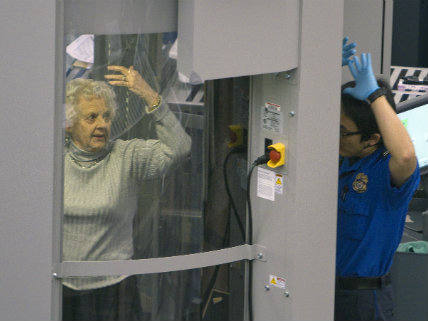Lawsuit Challenges TSA To Prove Body Scanners Aren't Killing People
Body scanners make some people choose driving over flying, but does that mean the TSA is responsible for deaths caused by traffic accidents?

When the Transportation Safety Administration was rolling out its brand new body scanning machines in 2010, the response was pretty much exactly what you would expect: 94 percent of public comments on the policy were opposed.
None of that made much of a difference to the TSA. Neither, apparently, did the cost or technical problems with the machines, which were installed in airports across the country and are still being used today.
Maybe the TSA should have spent some time reading through the 5,129 public comments opposing body scanners in airports. They might have noticed that, mixed in with concerns about the efficacy, cost and violations of personal privacy, there were a number of people—more than 80 of them—who said the use of the body scanners would cause them to reconsider flying at all.
One commenter at the time said they would prefer to drive across the country twice instead of "being subjected to what is clearly a violation of privacy by this intrusive form of airport passenger inspection."
Today, that person might be dead—and even if they're not, the TSA's use of body scanners has increased the likelihood, however minutely, that they are.
That's the premise of a lawsuit filed against the TSA by Iain Murray and Marc Scribner, research fellows at the Competitive Enterprise Institute.
In a brief filed this week in the D.C. Circuit Court of Appeals, Murray and Scribner argue that the TSA knew its body scanners would cause some segments of the public to switch from flying to driving, creating a safety issue because flying is the mathmatically safer form of transportation.
Despite that knowledge, the TSA didn't do the math to determine how many people might die because they wanted to avoid having TSA agents see pictures of their naked forms.
Scribner and Murray did.
They looked research by economists at Cornell University showing that a decline in 1 million passengers on planes would lead to an additional 15 fatalities on highways. Combining that with data about how many Americans fly every year and mixing in the fact that an estimated 1.5 percent of people (based on the comments on the TSA's policy shift) would rather drive than go through the body scanners, they had the ability to determine—in a rough way—how many people over the last six years might have died because they didn't want to fly.
The final tally?
"We came up with 184 additional road deaths due to that effect, of people driving rather than flying," Scribner told Reason on Thursday.
(Update: Scribner tells me via Twitter that this is an annual total calculated for the period between July 2014 and June 2015. If you include all six years that the body scanners have been in use, the estimated total is probably close to 1,000.)
If this all sounds a little bit theoretical, that's because it is. The lawsuit isn't claiming that anyone in particular has been harmed by the TSA's scanners—though Scribner claims he has standing for the legal challenge because he, like many Americans, regularly travels on airplanes and by car—but merely that the TSA didn't do the proper amount of math before rolling the hulking machines into airports and making passengers queue up for them.
The interesting thing is that the government actually does these assessments of theoretical trade-offs all the time.
The best example might be the federal rules for taking small children on planes. Under current regulations, parents are allowed to take children under two years old onto planes without buying a separate ticket and without putting the child in a seat belt. Occasionally, that puts kids' lives at risk—mostly from severe turbulance, rather than actual plane crashes.
About two decades ago, the Federal Aviation Administration considered banning those so-called "lap children" and requiring separate seats for them. Then, they did the math. The FAA found that making that policy change would lead many parents of young children to choose to drive instead of fly.
For every life saved by requiring small children to wear seat belts on planes, there would be an additional 16 fatalities on the road, the FAA concluded.
Morbid? Yes. But logical.
"This is an effect that aviation safety regulators have dealt with before, and this is a major effect," Scribner said. "All we're asking the court to do is require the TSA to go back and do this proper analysis."
By not doing that analysis, he says, the TSA is in violation of the law.
It's an interesting case, but not one that will probably be resolved anytime soon. Scribner says it's unlikely that there will be a ruling before next year.
For what it's worth, the TSA says this whole thing is too much funky math for them to handle.
"It is unclear to TSA how the risk associated with motor vehicles should influence TSA's decision making on airport screening," the agency said in its explanation of the body scanner policy. "Regardless of the safety or security risks associated with other modes of transportation, TSA should pursue the most effective security measures reasonable available so that the vulnerability of commercial air travel to terrorist attacks is reduced."
That's either a laudably intense focus on its mission or an example of tunnel vision.
It's understandable that the TSA wouldn't want to consider the possibility that making one form of travel so completely secure that no terrorist can get through could make other forms of travel slightly more dangerous. If it accepts that premise, it might have to accept other theories about its usefulness as a government agency.
The reality is that security always involves trade-offs. Understanding those trade-offs is essential to knowing whether invasive security measures are worth it.



Show Comments (27)